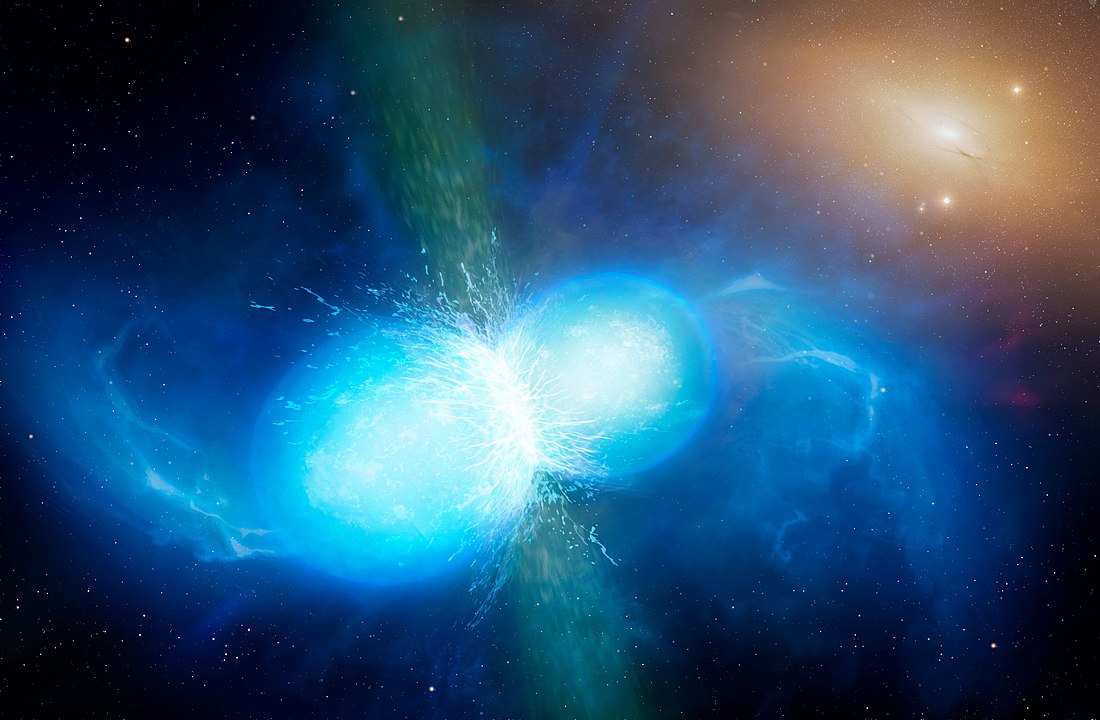Colliding neutron stars are the best particle accelerators

Gamma-ray telescopes observing neutron star collisions could hold the key to determining the composition of dark matter. One of the leading theories to explain dark matter is that it consists mainly of hypothetical particles called axions. If an axion is created in the intense energetic environment of the merger of two neutron stars, it should decay into gamma-ray photons, which we can see with space telescopes such as Fermi-LAT.
About 130 million years ago, a pair of neutron stars collided violently. Powerful gravitational waves from the collision were emitted outward at the speed of light, followed shortly thereafter by a massive burst of radio emission. On August 17, 2017, gravitational waves reached Earth and were detected by both detectors at the Laser Interferometer Gravitational-Wave Observatory (LIGO) in the United States and the Virgo interferometer in Italy. This event was named GW170817. A few seconds later, the Fermi-LAT gamma-ray telescope detected a burst of gamma rays in the same area of the sky. Over the next few days, other telescopes observed and recorded the event in visible light and other wavelengths. This is the first in history multi-channel surveillance of the merger of two neutron stars – that is, an observation that recorded waves and particles of different natures.
What is an axion?
One of the leading theories about the nature of dark matter is that it consists mainly of hypothetical particles called axions. If enough axions were created during the Big Bang, and if their masses fall within a certain range, then they could explain most of the dark matter that forms the Universe today. Unfortunately, axions have never been observed, and no one has yet confirmed whether they even exist. But according to Dr. Bhupal Dev of Washington State University, axions and axion-like particles (ALPs) could be created in the extreme conditions of neutron star collisions, and we could see signs of them from Earth.

Physicists have been trying to unravel the mystery of dark matter for decades. It seems likely that it may consist mainly of axions and axion-like particles, but these particles are only hypothetical for now. The axion was first proposed in 1977 as a solution to the strong CP problem, but its existence has not yet been confirmed.
The theory predicts, however, that axions may appear briefly due to the passage of high-energy photons through a powerful magnetic field. Such axions last only a short time and then decay back into a pair of gamma-ray photons. Currently, a number of experiments are being carried out around the world in which they are trying to create axions using this phenomenon and observing the gamma radiation from their decay. Others, such as Axion Dark Matter eXperiment (ADMX), look for axions that exist in nature, using a similar process to convert them into microwave photons.
But there are many places in the Universe where axions can appear in this way, including the cores of stars, the vicinity of magnetars, and other places with strong magnetic fields. One possible location is a neutron star collision site. When such dense objects collide, a huge amount of energy is released, including in the form of hard electromagnetic radiation and powerful magnetic fields: ideal conditions for the creation of axions!
By modeling these energy processes, researchers can predict the mass of axions that could appear there. From this they can infer the specific frequency of gamma ray photons that will be produced when they decay. If we are able to detect another such merger and reveal the specific spectrum of gamma rays produced by the collision, it will confirm that axions exist and provide evidence to support one of the leading theories about dark matter.
Natural particle accelerators

Such an experiment is not the first attempt by scientists to use natural phenomena instead of a particle accelerator. Our own upper atmosphere is one such place where high-energy particle collisions occur constantly. Unlike gamma rays, cosmic rays are subatomic particles that rush through space at relativistic speeds and are produced by catastrophic events such as supernovae. When they hit our atmosphere, they smash into air molecules with more force than we can create in our largest particle accelerators. Telescopes like High Energy Stereoscopic System (HESS) in Namibia, are designed to detect these collisions high in the sky. HESS is a pair of telescopes that look at the upper atmosphere and look for the characteristic bursts of Cherenkov radiation that show the cascades of particles created when cosmic rays collide with the atmosphere.
The observations of GW170817 have already been exploited by Dr Dev: careful analysis of the gamma rays observed by Fermi-LAT has helped narrow constraints on the properties of axions and axion-like particles.
Observations like these, combined with work from ground-based experiments such as ADMX, are critical to figuring out whether axions exist. And although they haven't found them yet, we still learn something new every time an experiment finds nothing. Each test is set up for a specific weight, so all these negative results narrow down the possibilities. We can only hope that the final answer will be received soon.





